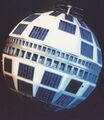Template:Selected anniversaries/July 23: Difference between revisions
Jump to navigation
Jump to search
No edit summary |
No edit summary |
||
| Line 33: | Line 33: | ||
||1972 – The United States launches Landsat 1, the first Earth-resources satellite. | ||1972 – The United States launches Landsat 1, the first Earth-resources satellite. | ||
||1990 – Kenjiro Takayanagi, Japanese engineer (b. 1899) Father of Japanese television. | ||1990 – Kenjiro Takayanagi, Japanese engineer (b. 1899) Father of Japanese television. Kenjiro Takayanagi (高柳 健次郎 Takayanagi Kenjirō, January 20, 1899 in Hamamatsu, Shizuoka – July 23, 1990 in Yokosuka) was a Japanese engineer and a pioneer in the development of television.[1] Although he failed to gain much recognition in the West, he built the world's first all-electronic television receiver, and is referred to as "the father of Japanese television". | ||
||1995 – Comet Hale–Bopp is discovered; it becomes visible to the naked eye on Earth nearly a year later. | ||1995 – Comet Hale–Bopp is discovered; it becomes visible to the naked eye on Earth nearly a year later. | ||
Revision as of 21:22, 29 October 2017
1829: William Austin Burt patents the typographer, a precursor to the typewriter.
1885: The well-known illustration Interview with Wallace War-Heels is stolen by math criminals, who demand computational ransom.
1928: Astronomer and academic Vera Rubin born. She will discover the discrepancy between the predicted angular motion of galaxies and the observed motion, by studying galactic rotation curves.
1962: Mathematician and crime-fighter Alice Beta uses Telstar to communicate with AESOP.
1962: Telstar relays the first publicly transmitted, live trans-Atlantic television program, featuring Walter Cronkite.
2017: AESOP re-broadcasts Walter Cronkite's 1962 trans-Atlantic television program.





